Ends of the Roads
Mid-August found us in the mountains of Ladakh with a few extra days to do some exploring. We’d heard of a beautiful place nearby called Phuktal Gompa, a monastery built into the honeycomb rock of a giant cave. We were excited because not only did the place look amazing, but going there also meant we would get to go off the beaten tourist track.
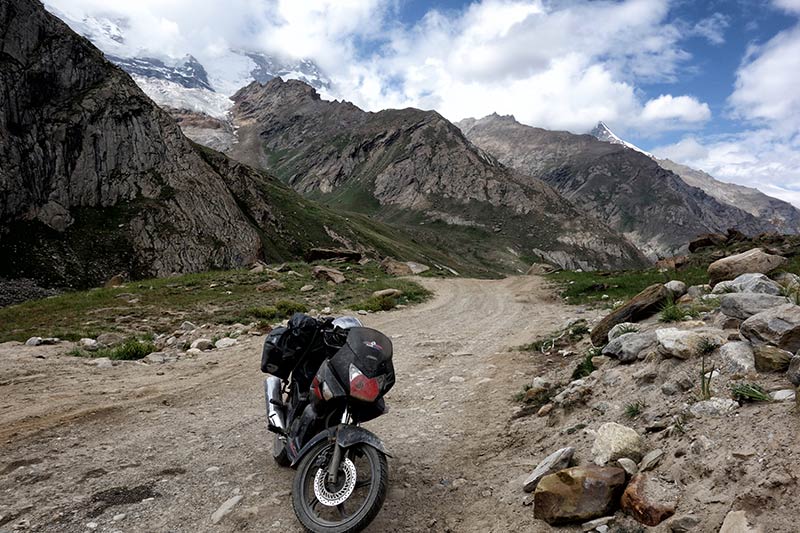
Ha, “off the beaten track.” Little did we know that we’d be waaaaaaay off the track. In fact, during this part of the journey, the track we were on would end (one way or another) four times. Let me explain…
We began cruising along the paved roads of Kargil on a Saturday morning. Kargil is one of the major cities between Srinagar and Leh along the 1D, so the pavement is well-kept. We headed down Zanskar Valley toward the monastery, and we were able to keep our motorcycles in 5th gear over smooth blacktop through the town of Sankoo for 38 glorious kilometers.
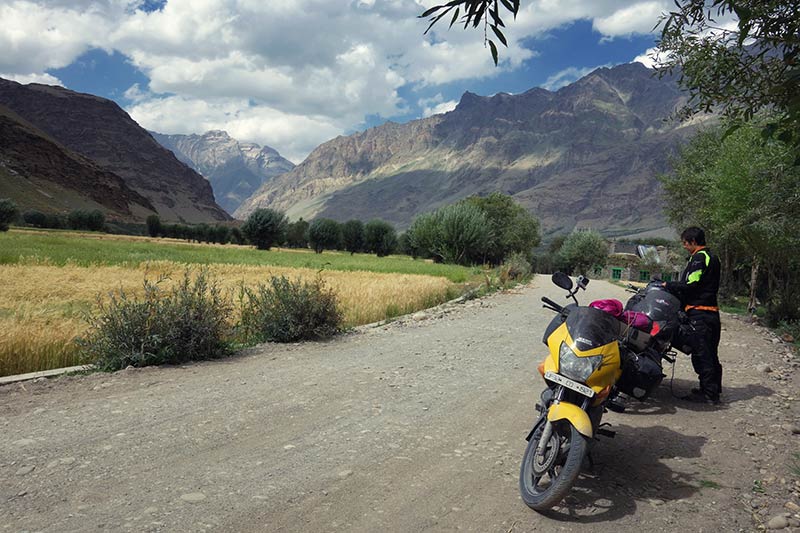
Then came the gravel. End of road one. It wasn’t bad at first, just tightly packed dirt and pebbles that meant we had to pay attention to our handling a bit more. We slowed down to 3rd gear, took corners carefully, and rumbled along at a decent pace. But the gravel soon gave way to potholes and rocks. The “road” was a constant barrage of bumps, and all we could do was slow down to 2nd and try to choose the best angle of approach. This jolty portion of the ride lasted a few more hours until we wearily reached the J&K Tourist guest house in Parkachik. With sore wrists and butts, we shakily dismounted, thankful to no longer be bouncing (insert your own joke here).
The next morning’s motorcycle ride presented a new challenge: water crossings. Most were only a few inches deep, but one stream was up to my knee. Riding through knee-deep water is dangerous because if you let up on the throttle, water gets sucked into the exhaust and the bike is dead; similarly, if you go too fast and tip over, your bike is on its side in deep water, and it's unlikely you'll be able to get it started up again anyway. We tossed around a few ideas, which included trying to build a pathway of rocks, turning back (boooo!), and waiting for other people to come by to help us carry the bikes over. In the end, we settled on the idea of having Sarah ride each bike across while I pushed/stabilized from behind. After two very nerve-racking runs, my feet were soaked, but the bikes were across safely. Booyah!
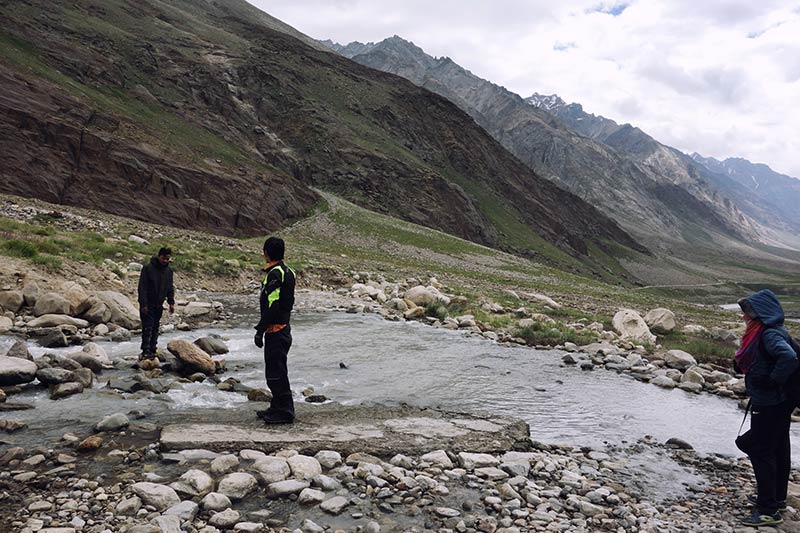
The next few hours were so bumpy that soon, riding wasn’t fun any more. Upon reaching a midsize town (Rangdum), we decided to pay to leave our bikes with a kind hotelkeeper and wait for a shared jeep. It was a relief to exchange the bone-jarring joltiness of our motorcycles for the slightly less painful bounciness of a jeep. The road was still peppered with potholes and rocks, but the jeep’s shocks ameliorated them a bit, and by nightfall we made it all the way to the city of Padum.
The next day, we packed our hiking backpacks and took another shared jeep from Padum to the little town of Raru, where the road ended a second time. A few local farmers pointed us toward a path that led further up into the mountains, and off we trekked. It was nice to finally get to test our hiking legs in India, and at an altitude of 12,000ft, we were really tested! The air was thin up there, and an hour of uphill climbing left me gasping. At one point, the trail even disappeared down a fifty foot drop, because a recent earthquake had shifted the supporting rock. We clambered down (which was the end of the third road) and then back up. When we finally reached a homestay that night, we were exhausted but satisfied with the day’s hike.
We got better at mountain trekking so that within the next two days, we were no longer wheezing after an hour of walking. We thought we were acclimating well… until we actually got to Phuktal Gompa, which was the end of road four. The monks there were really used to the altitude; those who were middle aged could hike in one day what it took us nearly two days to cover. And within the Gompa itself, the young monks were nimbly scampering up staircases that were labor-intensive for our fairly fit selves.
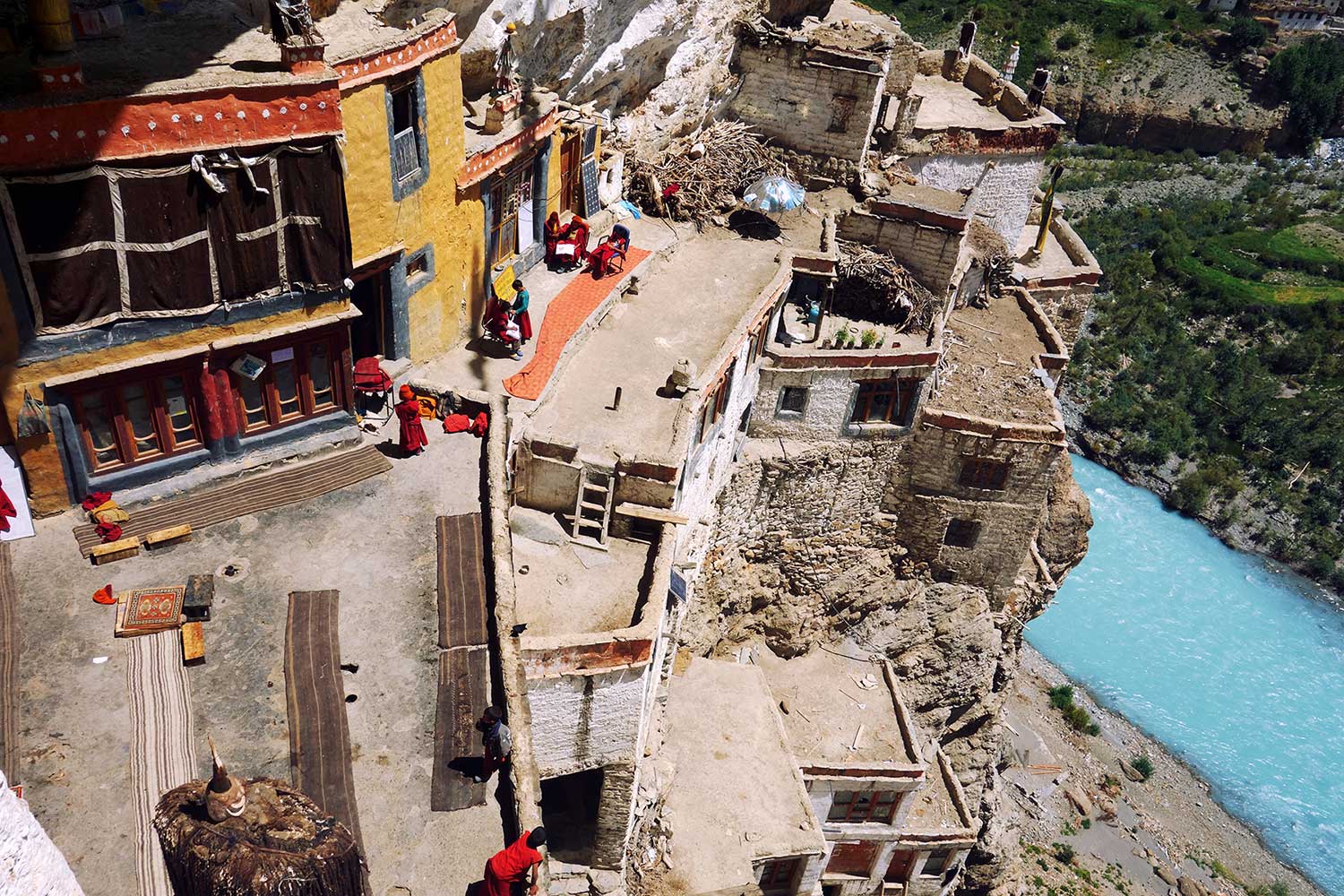
And speaking of the young monks, they were awesome. They wore burgundy robes down to their ankles, though some of the youngest were growing fast enough that the robes only came up to mid-shin. They had shaved heads that somehow amplified their solemnity when they were being serious and also amplified their silliness when they were being playful. And playful they were. For example, we were there when they were eating lunch, which consisted of plain roti (flatbread) and what looked like beans-n-rice in large quantities. A few of the young monks didn’t want to finish their portions, so when they thought none of the older monks were looking, they’d throw bits of food over the ledge.
We were also at Phuktal Gompa when the boys were having classes. These classes were held in a beautiful outdoor courtyard, and the boys were split up in small groups roughly by age. The youngest ones were working on reading - their teacher (an older monk) would say a word from their workbook, and then all of the boys would chant it in unison. Interestingly, I’m pretty sure they were learning English, but when the boys chanted it, I could not actually make out what they were pronouncing. A slightly older group of boys were working on math - their teacher wrote formulas on a whiteboard, and the boys would copy it down. The students in a third group were writing something - I couldn’t figure out what it was, but every so often the teacher would come by and whack the ground near one with a supple stick. The threatened student would write feverishly fast for a few seconds until the teacher walked out of range.
While the young monks continued their classes, Sarah and I divided our attention between watching them and watching the birds flying nearby. Phuktal Gompa, as I mentioned, is built in the honeycomb rock of a cave mouth, and there are birds that also nest in the lofty crevices of the cave. These birds wheeled and dove through the air in beautiful arcs that would make roller coaster designers jealous with envy. Some flew in lazy loops, occasionally catching updrafts back to their perches. Others rocketed down below our field of view for food (perhaps some of the sneakily discarded food from the young monks’ breakfast). Still others spiraled through the air, unaware that they were putting on a show for us mesmerized visitors.
After an evening of rest, we were ready to hike back the next day. About an hour into the trek, though, things started getting weird. Hiking up an incline, I started to feel odd, and after about 30 seconds, my vision started to blur. I sat down, and my eyes clouded over until I couldn’t see anything. It was like I’d gone blind. I was scared as hell; I kept waving my hand in front of my face, hoping it was just dizziness. Within a minute, my vision hazily returned, and I drank some water in relieved gulps. But my relief was short-lived, because about five minutes later, the blindness returned. Once, it was like my eyes weren’t working for a short time. Sarah eventually guided me into the shade, and we spent a worried half hour with my vision going in and out about every five minutes.
We took it slow the rest of the afternoon, and we eventually made it back to Padum the next evening with no more incidents. We rested well that evening, and then prepared to head back to where we’d left our bikes. But we hit a snag. There were no shared jeeps leaving that day! Some kind people in Padum recommended we wait along the roadside and try to hitch a ride which (after a few hours of waiting) we succeeded in doing… in a truck!
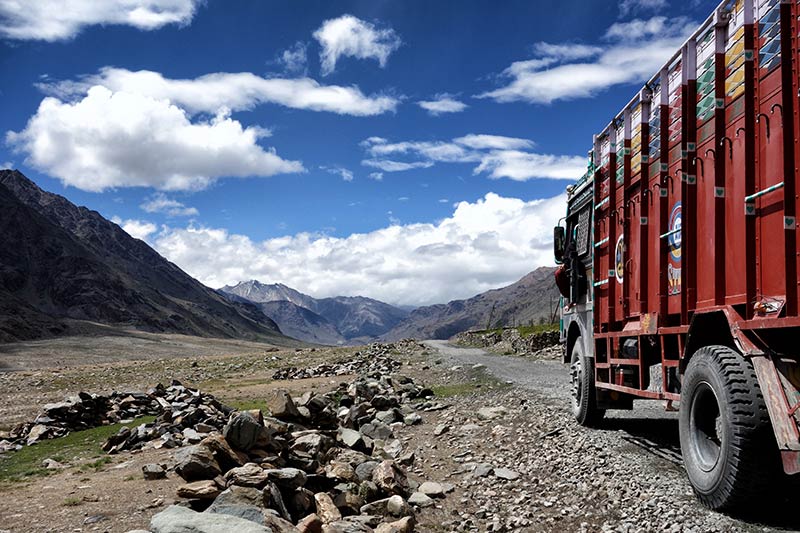
If you spend any amount of time traveling in India, you’ll recognize these trucks. We’d seen hundreds of them along the road, but it was another thing entirely to be in the cab of one. The cab is spacious, comfortable, and decked out with some awesome stuff! Ours had a mini kitchen under the seats, a comfy couch thing behind the driver, and a nice radio system for playing tunes. We rode with a few guys who were very friendly, and Sarah passed quite a bit of time talking with them in Hindi. They, like many other people in India, were really impressed with her fluency, and after a few hours of chatting over bumpy roads, they offered to share their lunch with us. I will never forget this meal; we were sitting outside the truck, in a gorgeous mountain valley, using our hands to eat messily delicious rice and chicken with truckers from the other side of the world.